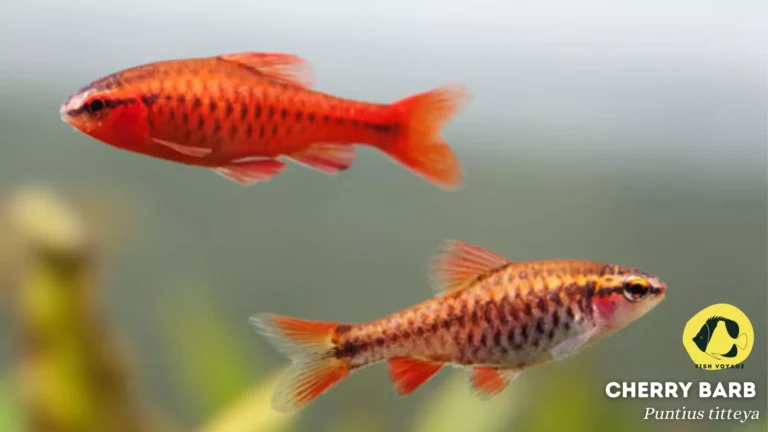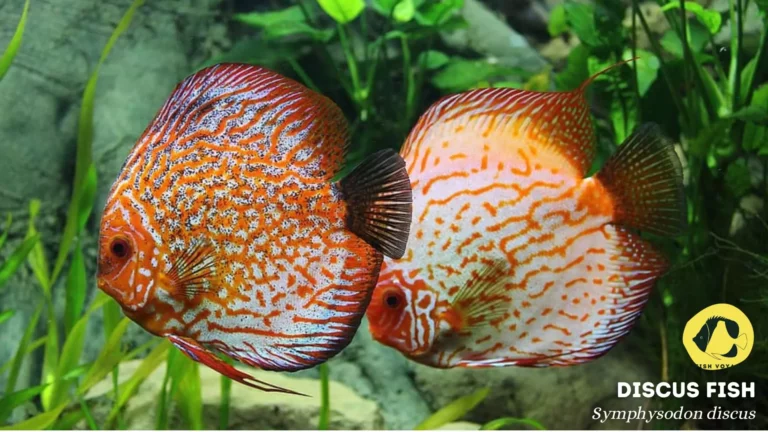Top 10 Room Temperature Aquarium Fish

Embarking on the journey of creating a room temperature aquarium offers aquarists a unique and accessible approach to aquatic hobbyism. Room temperature aquariums, devoid of the traditional heating apparatus, present an eco-friendly and cost-effective alternative for enthusiasts. The significance lies not only in the simplicity of maintenance but also in the careful selection of fish species that thrive in these conditions.
In this comprehensive guide, we delve into the nuances of room temperature aquariums, shedding light on the key factors influencing success. Choosing the right inhabitants for such setups is paramount, and we will explore top picks such as Guppies, White Cloud Mountain Minnows, and Betta Fish. Join us as we navigate the fascinating realm of room temperature aquariums, providing insights into proper care and ensuring a harmonious aquatic environment for both novice and seasoned hobbyists alike.
Understanding Room Temperature Aquariums
Definition and Benefits of Room Temperature Setups
- Definition: Room temperature aquariums, characterized by the absence of heating equipment, create a natural and energy-efficient aquatic habitat.
Benefits
- Energy Efficiency: Eliminating the need for heaters reduces energy consumption, making room temperature setups environmentally friendly.
- Cost-Effective: Reducing equipment requirements translates to lower setup costs and operational expenses.
Factors to Consider When Maintaining Room Temperature
Ambient Temperature
- Optimal Range: Choose fish species adaptable to the room’s average temperature to ensure their well-being.
- Monitoring: Regularly check ambient temperatures, especially during extreme weather conditions.
Seasonal Variations
- Temperature Fluctuations: Be mindful of seasonal changes affecting room temperature and make necessary adjustments.
- Adaptable Species: Select fish species resilient to seasonal variations for a stable environment.
Adequate Aeration and Filtration
- Oxygen Levels: Ensure proper aeration to maintain optimal oxygen levels, vital for the health of fish.
- Filtration Systems: Implement effective filtration to uphold water quality and remove impurities, contributing to a thriving ecosystem.
Navigating the intricacies of room temperature aquariums involves a strategic understanding of these key components. By embracing these factors, aquarists can create a sustainable, low-maintenance aquatic haven that benefits both the inhabitants and the environment.
Top 10 Room Temperature Fish Species
Guppy (Poecilia reticulata)
- Overview: Guppies are vibrant and versatile freshwater fish known for their striking colors and distinctive patterns, making them a favorite among aquarists.
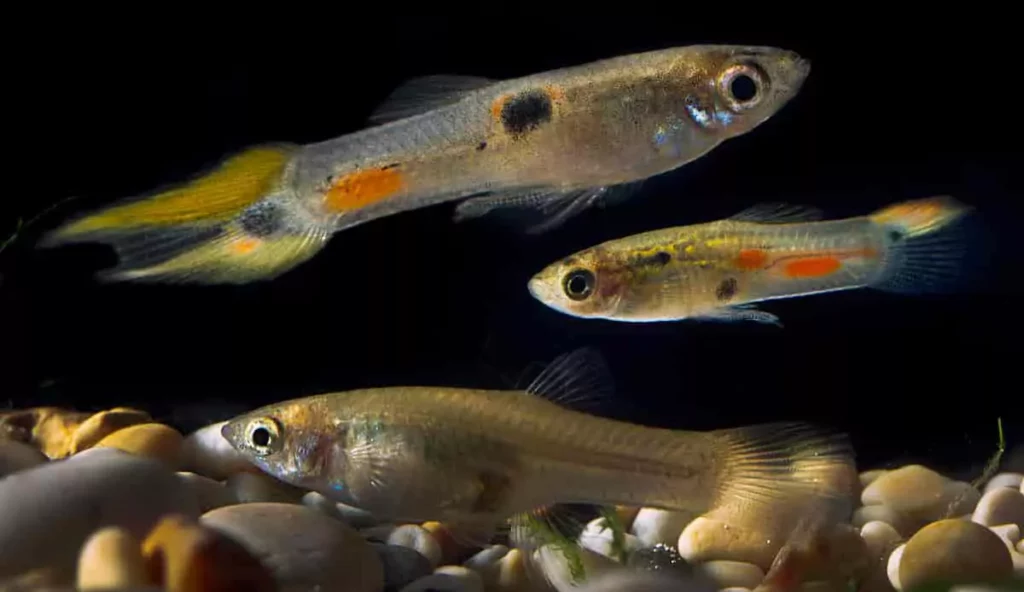
Characteristics and Behavior
- Colorful Displays: Males showcase a spectrum of hues, creating a visually stunning display.
- Social Nature: Guppies thrive in groups, displaying social behaviors and engaging interactions.
Tank Setup and Compatibility
- Community Tank Friendly: Guppies coexist well with other peaceful species, fostering a harmonious community.
- Planted Aquariums: Flourish in planted setups with ample hiding spots and swimming space.
Feeding and Health Considerations
- Varied Diet: Guppies are omnivores; a balanced diet of flakes, pellets, and live/frozen foods enhances their health.
- Water Parameters: Maintain stable water conditions, paying attention to pH levels and water hardness.
Tips for Care and Maintenance
- Regular Monitoring: Due to their prolific breeding, monitor population control to prevent overcrowding.
- Maintain Consistent Temperature: Ensure a stable room temperature to support their well-being.
White Cloud Mountain Minnow (Tanichthys albonubes)
- Overview: White Clouds are small, peaceful fish originating from mountain streams in Asia, renowned for their resilience.
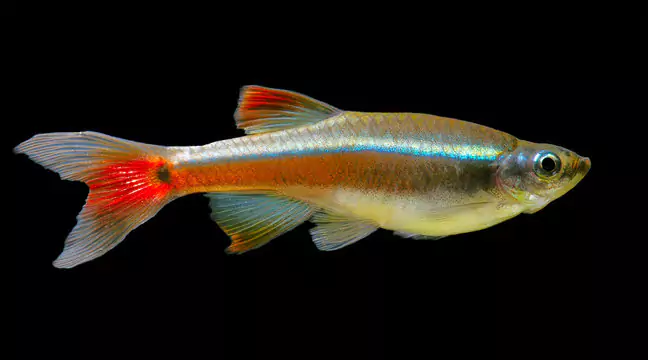
Characteristics and Behavior
- Schooling Behavior: Thrive in groups, displaying vibrant colors and engaging in schooling behavior.
- Adaptable: Resilient to varying water conditions, making them ideal for room temperature setups.
Tank Setup and Compatibility
- Peaceful Community: White Clouds are compatible with other non-aggressive species.
- Planted Tanks: Flourish in planted environments with subdued lighting.
Feeding and Health Considerations
- Small Particle Foods: Their small size benefits from finely crushed flakes and small live/frozen foods.
- Temperature Stability: Maintain consistent room temperature for their overall health.
Tips for Care and Maintenance
- Routine Water Changes: Regular water changes aid in maintaining optimal water quality.
- Monitor Group Dynamics: Observe their interactions to ensure a stress-free environment.
Betta Fish (Betta splendens)
- Overview: Betta fish, also known as Siamese Fighting Fish, are prized for their vibrant colors and elaborate fin displays.
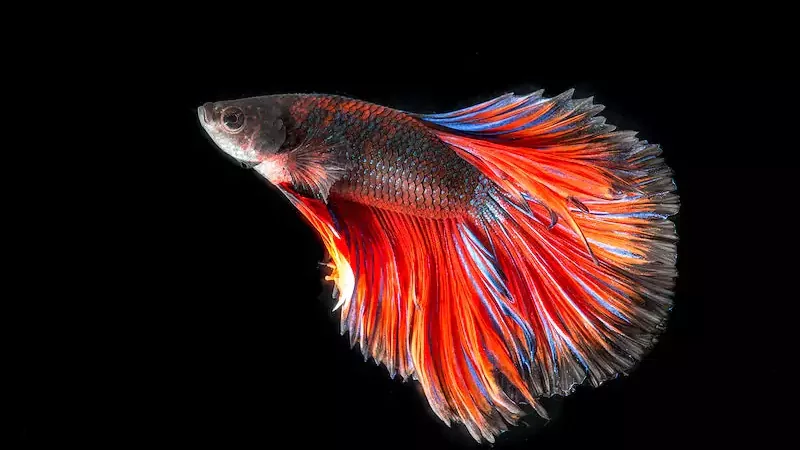
Characteristics and Behavior
- Labyrinth Organ: Betta’s ability to breathe air allows them to thrive in low-oxygen environments.
- Territorial Nature: Males can be territorial; consider appropriate tank mates.
Tank Setup and Compatibility
- Individual Housing: Male Bettas are best kept alone due to territorial aggression.
- Warm Water Tolerance: While room temperature is suitable, they prefer slightly warmer water.
Feeding and Health Considerations
- Varied Diet: Betta’s diet should include high-quality pellets and occasional live/frozen foods.
- Maintain Clean Water: Regular water changes and a well-filtered tank are crucial.
Tips for Care and Maintenance
- Baffle Filter Flow: Bettas prefer gentle water flow; consider baffling filter outlets.
- Enrichment Activities: Incorporate hiding spots and objects for mental stimulation.
Platy (Xiphophorus maculatus)
- Overview: Platies are colorful and easy-to-care-for fish that come in various color variations, adding vibrancy to any tank.
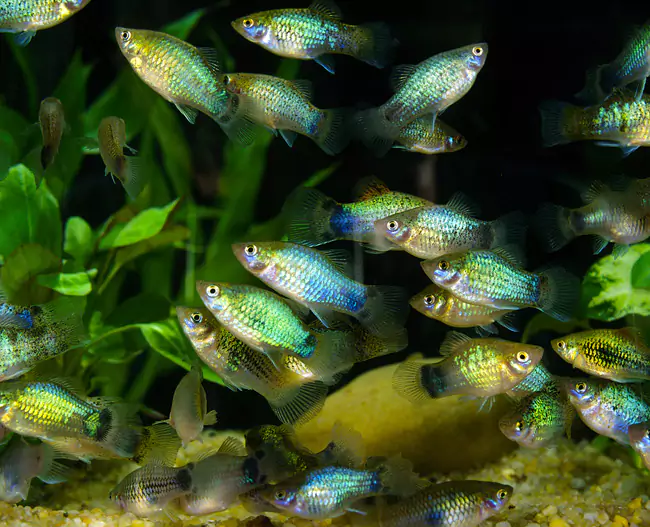
Characteristics and Behavior
- Peaceful Nature: Platies are known for their calm demeanor, making them suitable for community tanks.
- Livebearer: Like Guppies, Platies are livebearers, reproducing readily in captivity.
Tank Setup and Compatibility
- Planted Aquariums: Enjoy a well-planted tank with sufficient swimming space.
- Community Tank Mates: Compatible with other non-aggressive fish.
Feeding and Health Considerations
- Varied Diet: Omnivores that benefit from a diet including flakes, pellets, and occasional live/frozen foods.
- Water Quality: Maintain stable water conditions to support their overall health.
Tips for Care and Maintenance
- Provide Hiding Spots: Include hiding spots in the tank to reduce stress.
- Monitor Water Parameters: Regularly test and maintain appropriate water parameters.
Corydoras Catfish (Corydoras spp.)
- Overview: Corydoras Catfish are small, bottom-dwelling fish known for their charming appearance and social behavior.

Characteristics and Behavior
- Schooling Behavior: Prefer to be kept in groups, displaying social interactions.
- Algae Eaters: Help maintain a clean tank by consuming algae and leftover food.
Tank Setup and Compatibility
- Substrate Preference: Provide a soft substrate as they enjoy digging.
- Community Tank Friendly: Compatible with a variety of peaceful tank mates.
Feeding and Health Considerations
- Omnivorous Diet: Feed a balanced diet of sinking pellets, flakes, and occasional live/frozen foods.
- Avoid Overfeeding: Monitor and control food portions to prevent overfeeding.
Tips for Care and Maintenance
- Moderate Flow: Prefer tanks with moderate water flow to mimic their natural habitat.
- Routine Substrate Cleaning: Perform gentle substrate cleanings to remove debris.
Swordtail (Xiphophorus hellerii)
- Overview: Swordtails are known for their unique sword-like extension on the tail, adding an interesting dimension to the aquarium.
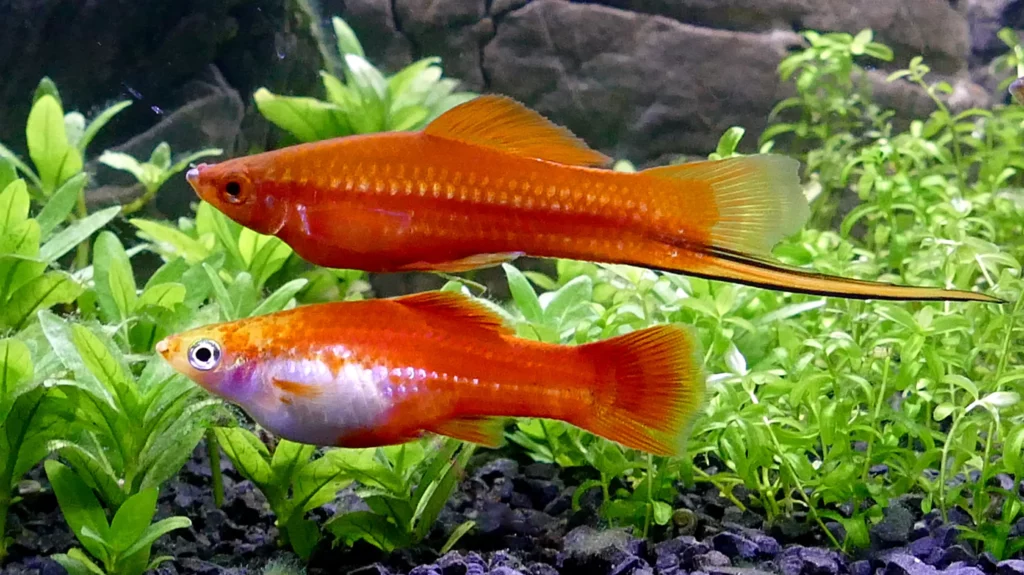
Characteristics and Behavior
- Active Swimmers: Swordtails are active and social fish, appreciating open swimming areas.
- Livebearer: Exhibit livebearing behavior, with females giving birth to live fry.
Tank Setup and Compatibility
- Planted Tanks: Enjoy aquariums with plants and open swimming spaces.
- Peaceful Community: Compatible with other non-aggressive species.
Feeding and Health Considerations
- Varied Diet: Omnivores that benefit from a diverse diet including high-quality flakes, pellets, and live/frozen foods.
- Temperature Stability: Maintain a stable room temperature for their well-being.
Tips for Care and Maintenance
- Provide Hiding Places: Incorporate hiding spots to alleviate stress.
- Regular Water Changes: Conduct routine water changes to ensure optimal water quality.
Rasbora (Rasbora spp.)
- Overview: Rasboras are peaceful schooling fish known for their subtle colors and interesting schooling behavior.
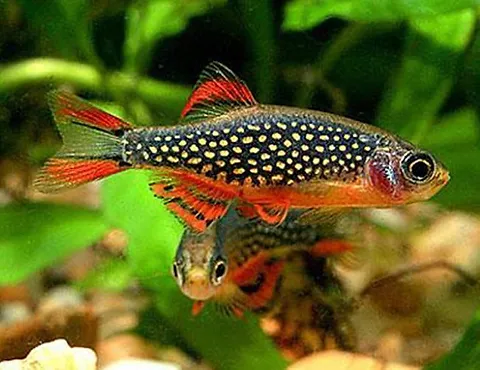
Characteristics and Behavior
- Schooling Dynamics: Thrive when kept in groups, showcasing schooling behavior.
- Peaceful Nature: Get along well with other non-aggressive community fish.
Tank Setup and Compatibility
- Planted Aquariums: Flourish in planted tanks with subdued lighting.
- Non-Aggressive Tank Mates: Ideal companions for other peaceful fish species.
Feeding and Health Considerations
- Small Mouths: Feed with appropriately sized, high-quality flakes and small live/frozen foods.
- Water Quality: Maintain stable water conditions for their overall health.
Tips for Care and Maintenance
- Dim Lighting: Appreciate aquariums with dimmed lighting to simulate their natural habitat.
- Peaceful Environment: Ensure a stress-free environment by avoiding aggressive tank mates.
Harlequin Rasbora (Trigonostigma heteromorpha)
- Overview: Harlequin Rasboras are known for their distinctive black triangular pattern, making them a visually appealing choice.

Characteristics and Behavior
- Schooling Nature: Prefer to be kept in groups, showcasing vibrant colors when in a school.
- Active Swimmers: Enjoy open swimming spaces in the middle and upper levels of the tank.
Tank Setup and Compatibility
- Planted Aquariums: Flourish in planted setups with ample swimming space.
- Peaceful Community: Compatible with other non-aggressive species.
Feeding and Health Considerations
- Small Mouths: Feed with appropriately sized, high-quality flakes and small live/frozen foods.
- Temperature Stability: Thrive in stable room temperatures.
Tips for Care and Maintenance
- Provide Dense Plants: Include dense vegetation for hiding and exploration.
- Routine Water Changes: Regular water changes contribute to their overall well-being.
Cherry Barb (Puntius titteya)
- Overview: Cherry Barbs are small, colorful fish known for their vibrant red hues, adding a burst of color to the aquarium.

Characteristics and Behavior
- Schooling Preference: Exhibit vibrant colors and social behavior when kept in schools.
- Peaceful Demeanor: Interact well with other non-aggressive species.
Tank Setup and Compatibility
- Planted Tanks: Flourish in planted aquariums with subdued lighting.
- Community Tank Friendly: Compatible with other peaceful fish species.
Feeding and Health Considerations
- Varied Diet: Feed a balanced diet of high-quality flakes, pellets, and occasional live/frozen foods.
- Water Quality: Maintain stable water conditions for their overall health.
Tips for Care and Maintenance
- Provide Hiding Spots: Incorporate hiding spots to alleviate stress.
- Monitor Social Dynamics: Observe school interactions to ensure a harmonious environment.
Neon Tetra (Paracheirodon innesi)
- Overview: Neon Tetras are iconic for their stunning blue and red coloration, adding a captivating glow to freshwater aquariums.

Characteristics and Behavior
- Schooling Behavior: Display vibrant colors and schooling behavior, especially in larger groups.
- Peaceful Schooling Fish: Interact well with other non-aggressive fish.
Tank Setup and Compatibility
- Planted Aquariums: Flourish in well-planted tanks with dimmed lighting.
- Non-Aggressive Tank Mates: Ideal companions for other peaceful species.
Feeding and Health Considerations
- Small Mouths: Feed with appropriately sized, high-quality flakes and small live/frozen foods.
- Temperature Stability: Thrive in stable room temperatures.
Tips for Care and Maintenance
- Dim Lighting: Appreciate aquariums with dimmed lighting to simulate their natural habitat.
- Provide Shelter: Include plants and decorations to offer shelter and security.
Tips for Room Temperature Aquarium Success
Monitoring and Adjusting Water Temperature
Regular Temperature Checks
- Importance: Consistently monitor the room temperature to ensure it aligns with the needs of your fish.
- Tip: Use a reliable aquarium thermometer for accurate readings.
Adjustments for Seasonal Variations
- Consideration: Be mindful of seasonal changes impacting room temperature.
- Tip: Make gradual adjustments to the aquarium heater, if necessary, during extreme temperature fluctuations.
Heater-Free Strategies
- Advantage: Capitalize on the benefits of room temperature setups by eliminating the need for heaters.
- Tip: Choose fish species that thrive in stable room temperatures to simplify temperature management.
Proper Feeding Habits for Room Temperature Fish
Varied and Balanced Diet
- Importance: Provide a diverse diet to meet the nutritional needs of your fish.
- Tip: Include high-quality flakes, pellets, and occasional live or frozen foods for a well-rounded diet.
Portion Control
- Consideration: Prevent overfeeding, which can lead to water quality issues.
- Tip: Feed your fish small, frequent meals, adjusting quantities based on their needs.
Observation During Feeding
- Importance: Monitor fish behavior during feeding for signs of health or stress.
- Tip: Adjust feeding habits based on individual preferences and activity levels.
Maintenance Routines for Optimal Health
Regular Water Changes
- Importance: Maintain water quality by performing routine water changes.
- Tip: Schedule regular, partial water changes to remove impurities and refresh the aquarium environment.
Gravel Vacuuming
- Consideration: Eliminate debris from the substrate to prevent the buildup of harmful substances.
- Tip: Use a gravel vacuum during water changes to remove uneaten food and waste.
Filter Maintenance
- Importance: Ensure the proper functioning of your aquarium filter for effective water filtration.
- Tip: Clean or replace filter media as recommended by the manufacturer to avoid clogging.
Seasonal Adjustments and Considerations
Temperature Monitoring in Different Seasons
- Consideration: Be aware of temperature fluctuations during different seasons.
- Tip: Adjust room temperature or consider supplementary heating or cooling if needed to maintain a stable environment.
Adapting Fish Species
- Importance: Some fish may be more adaptable to seasonal changes than others.
- Tip: Choose fish species that align with the natural temperature variations in your location.
Aeration in Warmer Weather
- Consideration: Warmer temperatures may lead to decreased oxygen levels.
- Tip: Increase aeration during warmer months to ensure optimal oxygenation for your fish.
Ensuring the success of your room temperature aquarium involves a combination of vigilant monitoring, thoughtful feeding practices, regular maintenance routines, and considerations for seasonal changes. By implementing these tips, aquarists can create a stable and thriving environment for their aquatic companions.
Common Mistakes to Avoid
Overstocking the Aquarium
Understanding Bio-Balance
- Importance: Recognize the capacity of your aquarium to maintain a healthy biological balance.
- Tip: Research and adhere to recommended stocking levels based on the size and filtration capacity of your tank.
Consideration for Fish Size
- Mistake: Overestimating the available space for fish to grow.
- Tip: Choose fish species that are compatible with your aquarium size, considering their adult size.
Behavioral Compatibility
- Importance: Avoid overcrowding to prevent territorial disputes and stress among fish.
- Tip: Research the social behaviors of your chosen species and plan the aquarium layout accordingly.
Neglecting Water Quality
Inadequate Filtration
- Mistake: Underestimating the importance of an efficient filtration system.
- Tip: Invest in a quality filter that matches the size of your aquarium and perform regular maintenance.
Irregular Water Changes
- Mistake: Neglecting the significance of routine water changes.
- Tip: Establish a schedule for regular, partial water changes to prevent the accumulation of harmful substances.
Overfeeding Practices
- Importance: Overfeeding leads to excess waste and deteriorates water quality.
- Tip: Feed your fish in controlled portions, observing their consumption habits.
Ignoring Signs of Stress in Fish
Behavioral Changes
- Mistake: Overlooking subtle changes in fish behavior.
- Tip: Regularly observe fish for signs of stress, such as reduced activity, hiding, or aggression.
Physical Symptoms
- Mistake: Disregarding physical indications of stress, such as color changes or abnormal swimming patterns.
- Tip: Act promptly if you notice any unusual behavior or physical symptoms, seeking advice from experienced hobbyists or professionals.
Inadequate Hiding Places
- Mistake: Not providing sufficient hiding spots for fish to retreat and alleviate stress.
- Tip: Incorporate plants, decorations, and structures that offer shelter and security.
Lack of Research on Specific Species
Impulse Purchases
- Mistake: Acquiring fish without adequate knowledge of their specific requirements.
- Tip: Thoroughly research each species before introducing them to your aquarium, considering their compatibility and care needs.
Mismatched Tankmates
- Mistake: Pairing incompatible fish species in the same tank.
- Tip: Choose tankmates with similar temperaments, size, and environmental preferences to avoid conflicts.
Neglecting Individual Species Traits
- Importance: Each species has unique characteristics and care requirements.
- Tip: Tailor your tank setup, feeding regimen, and water conditions to accommodate the specific needs of each fish species.
By steering clear of these common mistakes, aquarists can establish and maintain a successful room temperature aquarium, fostering a thriving and harmonious aquatic environment for their fish. Regular research, attentive observation, and proactive care contribute to the long-term health and well-being of the aquarium ecosystem.
Conclusion
As we conclude this exploration into the realm of room temperature aquariums, let’s revisit the key elements that contribute to a successful and fulfilling aquatic experience.
Recap of Key Points
- Eco-Friendly Simplicity: Room temperature aquariums offer an eco-friendly and straightforward alternative, reducing energy consumption and costs associated with heating equipment.
- Species Selection: Choosing suitable fish that thrive in stable room temperatures is paramount to the well-being of your aquatic companions.
- Balanced Care: Regular monitoring of water temperature, mindful feeding habits, and diligent maintenance routines contribute to the overall health of your aquarium.
- Avoiding Pitfalls: Steering clear of common mistakes such as overstocking, neglecting water quality, and ignoring signs of stress ensures a thriving aquatic ecosystem.
Encouragement for Beginners to Try Room Temperature Setups
Embarking on the journey of maintaining a room temperature aquarium is not only a practical choice but also an enriching one. For beginners venturing into the world of aquatic hobbyism, room temperature setups offer a gentle introduction, eliminating the complexity associated with heating equipment. The carefully curated selection of fish species highlighted in this guide provides an ideal starting point for those eager to create a captivating underwater world without the added challenge of temperature control.
Call-to-Action for Comments and Questions from Readers
As we strive to build a community of passionate aquarists, your thoughts, comments, and questions are invaluable. Share your experiences, insights, or any additional tips you may have for maintaining room temperature aquariums. If you have questions or specific topics you’d like us to cover in future articles, don’t hesitate to reach out. Let this space be a hub for knowledge exchange, where the collective wisdom of the community enhances the journey of every aquarium enthusiast.
In the spirit of fostering a vibrant community, we invite you to engage with us and your fellow readers. Your participation not only enriches the conversation but also contributes to the shared knowledge that makes our collective exploration of the aquatic world more rewarding.
Thank you for joining us on this odyssey into the world of room temperature aquariums. May your aquariums flourish with life and color, creating a source of joy and inspiration for you and your aquatic companions.
Additional Resources
Links to Reputable Forums for Further Information
For ongoing support and a deeper exploration of room temperature aquariums, consider joining reputable online forums where experienced aquarists and enthusiasts share their knowledge and experiences. Engaging in these communities can provide valuable insights, troubleshooting tips, and a sense of camaraderie. Here are some highly regarded forums to expand your understanding.
- AquariumAdvice: A diverse community of aquarists sharing advice on various aspects of aquarium keeping.
- Fishlore: An informative forum with a focus on freshwater and marine aquariums, featuring discussions on room temperature setups.
- Reddit – Aquariums Community: A dynamic Reddit community discussing a wide range of aquarium-related topics, including room temperature setups.
Recommended Products for Room Temperature Aquarium Setups
To enhance your room temperature aquarium experience, here are some recommended products that align with the principles of simplicity and efficiency.
- Hydor Koralia Nano Aquarium Circulation Pump: A compact and energy-efficient circulation pump to ensure proper water flow and oxygenation in your aquarium.
- Fluval 106 External Filter: A reliable external filter providing effective mechanical and biological filtration without the need for an additional heater.
- API Freshwater Master Test Kit: An essential water testing kit to monitor key parameters and maintain optimal water quality in your room temperature aquarium.
- Aqueon LED Aquarium Light Fixture: An energy-efficient LED light fixture providing ample illumination for a planted room temperature aquarium.
Investing in quality products ensures the well-being of your aquatic community and contributes to the overall success of your room temperature aquarium. Please note that these are recommendations, and it’s essential to adapt products based on the specific needs of your aquarium and the fish species you choose to keep.
Feel free to explore these resources and products to further enrich your room temperature aquarium journey. May your aquatic endeavors be filled with success and the joy of creating a thriving underwater oasis.
Frequently Asked Questions (FAQs)
1. Can I keep tropical fish in a room temperature aquarium?
While many tropical fish species prefer warmer temperatures, there are numerous room temperature fish options that thrive in the 68-75°F (20-24°C) range. Consider species like Guppies, White Cloud Mountain Minnows, and Betta Fish that adapt well to stable room temperatures.
2. Do I need a heater for a room temperature aquarium?
Room temperature aquariums are designed to function without heaters. Choosing fish species that naturally thrive in the typical room temperature range eliminates the need for additional heating equipment. Ensure to research and select species compatible with your ambient room temperature.
3. How do I monitor and maintain stable room temperature in my aquarium?
Use a reliable aquarium thermometer to regularly check the room temperature. Make adjustments based on seasonal variations and consider the preferences of your chosen fish species. Adequate insulation and avoiding drastic temperature fluctuations in the room contribute to a stable environment.
4. Can I mix room temperature fish with those requiring warmer water?
It’s advisable to choose fish species with similar temperature preferences to maintain a harmonious environment. Mixing room temperature fish with those requiring warmer water may result in stress or health issues for one or more species. Research and select compatible tank mates to avoid conflicts.
5. How do I acclimate fish to a room temperature aquarium?
When introducing fish to a room temperature aquarium, employ a gradual acclimation process. Float the fish in the bag or container in the aquarium water, allowing them to adjust to the temperature. Slowly mix water from the tank into the bag over 15-30 minutes before releasing the fish into their new environment.


